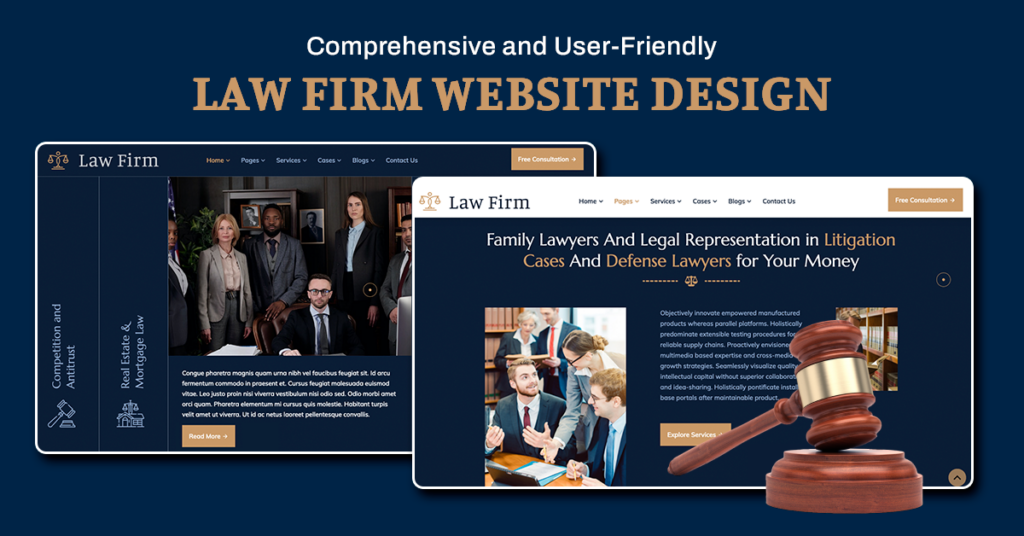
In today’s competitive legal landscape, having the best law firm website design with a professional and user-friendly design is essential. A well-crafted website builds credibility and ensures your services are accessible to a broader audience, especially in regions like Malaysia, Singapore, and the US, where mobile usage is high. Here’s how to create a comprehensive, client-focused legal and best law firm website that stands out.
In today’s digital age, having a professional website is crucial for law firms to establish their online presence, increase credibility, and reach targeted clients. A well-designed website can make a significant difference in a law firm’s ability to attract new clients and grow their business.
Increase Credibility and Online Presence
A website is an essential tool for law firms to establish credibility and showcase their expertise. According to a study, 84% of consumers believe that businesses with a website are more credible. A professional website can help law firms to create a strong online presence, which is critical in today’s digital landscape. By having a website, law firms can demonstrate their commitment to their clients and showcase their expertise in their practice areas.
Reach Targeted Clients and Improve Search Engine Visibility
A website can help law firms to reach targeted clients and improve their search engine visibility. By optimizing their website for search engines, law firms can increase their chances of appearing in search engine results pages (SERPs) and attract more visitors to their website. This can lead to more leads, conversions, and ultimately, more clients than other law firms. Additionally, a website can provide law firms with a platform to showcase their services, expertise, and values, which can help to attract targeted clients who are looking for specific legal services.

Understanding the Audience
A successful law firm website isn’t just about showcasing your firm’s expertise; it’s about understanding the emotional and practical needs of your potential clients. Whether they’re dealing with family law matters, personal injury, or criminal defence, your website should resonate with them on a personal level. Let’s break down the journey to building user empathy and ensuring your solicitor website fosters trust and engagement.
Identifying Client Concerns and Needs
For many clients, seeking legal help can be overwhelming, especially in sensitive areas like family law or personal injury. A user-friendly law firm website must address these concerns by offering clear, accessible information. Consider the client’s emotional state—are they confused, anxious, or seeking justice? Your own law website design and content should gently guide them through their options, showing that your law firm understands their concerns and is ready to provide the legal support they need.
By using language that speaks directly to the user’s situation, such as “We’re here to support you through your family law case” or “Get the justice you deserve with expert personal injury representation,” you create a connection that feels authentic and empathetic.
Tailoring Content to Different Practice Areas
Each practice area, on other law firm websites whether it be family law, personal injury, or criminal defence, serves a distinct set of clients, each with their own specific needs. To ensure your solicitor website resonates with a broader audience, your content should be segmented by practice areas. This enables potential clients to easily find the legal help they need based on their particular case type.
For example, a personal injury law firm page should highlight successful outcomes, explain the legal process, and outline how your firm advocates for fair compensation. Meanwhile, a family law page should emphasise compassion and support during emotionally charged cases like divorce or child custody disputes. Criminal defence pages, on the other hand, should highlight the importance of protecting client rights in criminal defense, and the dedication your firm has to ensuring a fair trial.
Offering User-Friendly Legal Guidance
Clients visiting your law firm website are often in need of clear guidance, especially if they are new to the legal process. Use plain, concise language free from legal jargon, making it easy for users to understand how your services can help. This is particularly important for family law and criminal defence, where clients may be navigating legal matters for the first time.
An intuitive user experience (UX) on your solicitor website ensures that clients can quickly find the information they need. From outlining your legal firm’s practice areas, to showcasing your experience, the journey should feel seamless. Empathy in web design also involves anticipating common questions and concerns and addressing them proactively with FAQs, articles, or videos, thus helping visitors feel supported from their very first click.
Engaging Visual and Emotional Design
Visual design plays a significant role in the user empathy journey. Beyond aesthetics, your website’s design should evoke trust and professionalism. High-quality imagery, such as photos of your legal team working with clients or attending court, can humanise your law firm’s brand, making it feel more approachable.
For sensitive practice areas like family law and personal injury, visual elements of web designer should reflect compassion and reassurance. Subtle design choices—such as calming colour schemes, empathetic language in call-to-action buttons (e.g., “Contact Us for Immediate Help”), and the strategic placement of success stories—can significantly enhance the emotional experience of your site’s visitors.
Seamless Access to Legal Help
A critical part of the empathy journey is making sure website visitors feel comfortable reaching out for help. Clear, accessible contact options—such as prominent phone numbers, email links, and consultation forms—should be easy to find on every page of your solicitor website. Whether it’s a family law consultation or a personal injury claim, potential clients should feel encouraged and reassured that help is just a click away.
Consider offering live chat options, enabling immediate interaction for those seeking urgent legal help. Additionally, using strong calls-to-action (CTAs) like “Get the Legal Representation You Deserve” or “Schedule a Free Consultation” will drive engagement and help convert visitors into clients.

Key Elements of a Comprehensive Design
A comprehensive law firm’s website design integrates several crucial elements. Clarity and simplicity are at the forefront. The language used should be free of legal jargon, making it accessible to the layperson. The site’s navigation should be intuitive, allowing visitors to find the information they need without confusion. Services and expertise should be clearly outlined from the get-go.
Responsive design is another critical element. In an era where mobile internet usage is prevalent, the website must perform flawlessly across various devices and browsers. This ensures that the site is accessible to all potential clients, regardless of how they access the internet.
The aesthetics of the website should not be overlooked. A professional look and feel, through a thoughtful colour scheme and high-quality imagery, can significantly enhance credibility. This visual appeal should align with the firm’s brand and ethos.
Content quality is equally important. The website should serve as a resource, offering valuable content like articles, case studies, and insights into legal matters. A professional web designer and regularly updated blog section can help establish the firm’s authority in its field of expertise.
Professional Imagery and Branding for Law Firms
A website can also help law firms to establish a strong brand identity and showcase their professional imagery. By using high-quality images, logos, and typography, law firms can create a visually appealing website that reflects their values and expertise. This can help to establish trust and credibility with potential clients and differentiate law firms from their competitors.

Enhancing User Experience
Enhancing the user experience is about creating a great law firm website that is accessible and easy to navigate. This includes a clear menu structure and strategic placement of calls-to-action, guiding visitors through the site and to the information they seek.
Accessibility features are essential. The website should cater to all users, including those with disabilities. Features like screen reader compatibility and easily clickable links ensure that the site is inclusive.
Website performance is also a key aspect of user experience. Optimising images and scripts for quick load times and choosing reliable hosting minimises downtime, ensuring that the site is always available when clients need it.
Multiple contact options, such as phone, email, and chat, along with a comprehensive FAQ section, can significantly enhance user support and engagement.
Leverage Calls-to-Action and CTAs
Finally, a website can help law firms to leverage calls-to-action (CTAs) and convert visitors into leads. By using clear and prominent CTAs, the best law firm websites, firms can encourage visitors to take action, such as filling out a contact form, scheduling a consultation, or making a phone call. This can help to increase conversions and ultimately, drive more business for the law firm. By incorporating CTAs into their website, law firms can create a clear path for visitors to follow and increase their chances of converting them into clients.

SEO and Marketing
Law firm websites must be visible and easily discoverable. This is where SEO and marketing come into play. Implementing SEO best practices, such as using relevant keywords and optimising meta tags, helps improve the site’s ranking in search engine results.
Content marketing strategy is another powerful tool. By sharing insightful and relevant content, the firm can engage more effectively with its target audience. Active participation in social media also increases the firm’s online visibility.
Finally, using analytics tools to track website performance and adapting the site based on user feedback and data is crucial for continuous improvement and relevance.
Keeping Your Site Updated and Secure
After your multi practice law firm website is live, ongoing website maintenance is essential for ensuring it stays updated, secure, and optimized. Regular updates help keep the site running smoothly, improving performance and user experience. Maintenance also includes checking for security vulnerabilities, updating plugins, and ensuring compliance with evolving legal standards like GDPR and PDPA. A well-maintained website not only prevents issues but also boosts SEO rankings by ensuring that the site remains functional and fast-loading, making a lasting positive impression on your clients.
Engaging the Right Web Design Company
When choosing a web design Malaysia company for your law firm, it’s essential to find a partner who understands both the legal industry and the importance of digital performance. Look for a company that emphasizes mobile responsiveness to ensure clients can easily access your site, especially in mobile-first markets like Malaysia and Singapore. Ensure they have expertise in both law firm websites and SEO strategies, including the use of localized and industry-specific keywords such as “best law firm web design” and “responsive lawyer websites.”
Additionally, a good web design company should help you craft clear, legally specific calls-to-action (CTAs) that convert visitors into clients. CTAs like “Get Your Legal Website Now” or “Contact Us for a Free Consultation” are crucial for encouraging engagement. It’s also important that they prioritize data security and legal compliance to protect sensitive client information, ensuring your site meets regulations such as GDPR (in the US) and PDPA (in Malaysia and Singapore).
By focusing on these areas, you can ensure your law firm’s website is not only visually appealing but also user-friendly, secure, and optimized for search engines, enhancing your family law firm’s visibility and client engagement across Malaysia, Singapore, and the US. This is particularly important for a boutique corporate law firm, which needs a professional yet engaging online presence to attract and retain clients.




